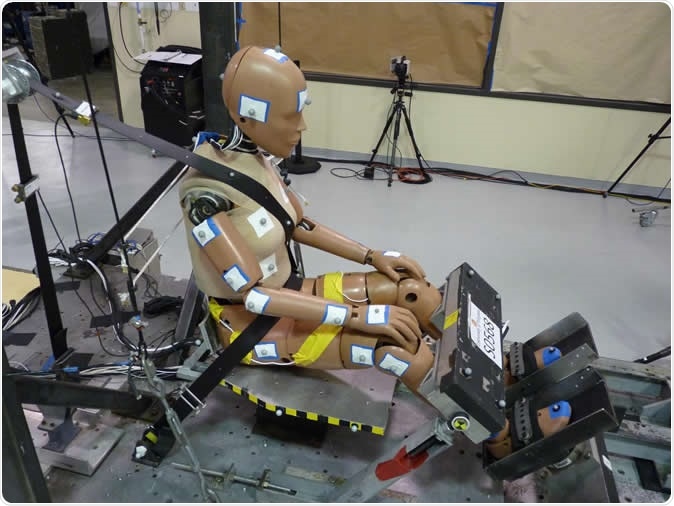Research has shown that over the last decade, cars have been rendered safer compared to older models. They are more resilient to frontal collisions say experts than before. Frontal collisions remain one of the commonest types of car crashes.
Now the researchers at the University of Virginia's Center for Applied Biomechanics have shown that despite these safety measures, women – even while they are wearing seat belts, are more prone to injuries due to the car crashes compared to the men. The results of the study were published this week in the latest issue of the Traffic Injury Prevention. The study was titled, “Automobile injury trends in the contemporary fleet: Belted occupants in frontal collisions.”

The Center for Applied Biomechanics is crash-testing an industry-standard dummy that is designed to represent a 5th percentile female (5 feet tall, weighing 110 pounds). These tests will help evaluate how realistic the dummy is in representing a real female automobile occupant. Image Credit: UVA Center for Applied Biomechanics
Jason Forman, a principal scientist with the Center for Applied Biomechanics in a statement said, “Until we understand the fundamental biomechanical factors that contribute to increased risk for females, we'll be limited in our ability to close the risk gap. This will take substantial effort, and in my view the National Highway Traffic Safety Administration does not have the resources needed to address this issue.”
For this study the team collected crash and injury data from the National Automotive Sampling System Crashworthiness Data System between 1998 and 2015. All the police-recorded cases during this period were in the database and were used for the analysis. The team included the impact of frontal collisions in all victims over the age of 13 years. There were nearly 23,000 frontal crashes and over 31000 victims have been recorded. The numbers of females and males among the injury victims are similar, the team wrote. Pregnant women beyond their first trimester of pregnancy were excluded from the analysis. Frontal collisions were defined as those between “10 o’clock to 2 o’clock”.
The team explains that belted women travellers in the new cars that are generally safer than their older counterparts are at a 73 percent greater risk of being injured seriously in the frontal collisions of the cars compared to men who are belted. The team took into consideration all the other factors such as age of the occupant, severity of the collision, stature and body mass index of the occupant as well as a vehicle model and year. Despite controlling for all these factors, the risk among women remain high the researchers wrote.
The risk of injuries to the women is commonly highest in the lower limbs they add. Injuries to those over 66 years are commonly those to the rib cage and chest the team wrote. There is a lowered risk of skull fractures, cervical spine injuries and injuries to the abdomen with the new car models wrote the researchers. There has also been a reduction in injuries to the hips, thighs and knees, they add. This has been a welcome change. What needs to reduce is the risk of rib fractures and fractures to the breast bone or sternum, they wrote. Injuries to the hands, arms and wrists are also unchanged over the years with change and modification of car models, the team wrote.
Forman explained, “For belted occupants in frontal collisions, substantial reductions in injury risk have been realized in many body regions in recent years. These results provide insight into where advances in the field have made gains in occupant protection, and what injury types and risk factors remain to be addressed.”
Authors concluded in their study, “For belted occupants in frontal collisions, substantial reductions in injury risk have been realized in many body regions in recent years. Risk reduction in the thorax has lagged other body regions, resulting in increasing prevalence among skeletal injuries in newer model year vehicles (especially in the elderly).” They sign off, “These results provide insight into where advances in the field have made gains in occupant protection and what injury types remain to be addressed.”
The study was supported and funded by the Autoliv Research.
Related study
Authors Classen and colleagues from University of Florida in April this year came up with a review titled, “Smart In-Vehicle Technologies and Older Drivers: A Scoping Review” in the journal OTJR (Thorofare N J).
The team wrote that advent of “in-vehicle information systems (IVIS)” or “advanced driving assistance systems (ADAS)”, have decreased the crash risk of the car among drivers. They examined the effects of IVIS and ADAS on older drivers in terms of comfort, safety and convenience. For this they gathered data from 28 studies that has used simulators or on-road experiments.
The team noted that these technologies have improved the safety of the cars and has also countered the decline in safety as the age of the drivers rose. The team wrote that with age drivers tended to experience a decline in their cognitive abilities. This was countered by the technologies. They wrote, “The ADAS enhanced safety and comfort by increasing speed control, lane maintenance, and braking responses.” They called for more real-life situation studies to prove their hypothesis.
Source:
Journal references:
- Jason Forman, Gerald S. Poplin, C. Greg Shaw, Timothy L. McMurry, Kristin Schmidt, Joseph Ash & Cecilia Sunnevang (2019) Automobile injury trends in the contemporary fleet: Belted occupants in frontal collisions, Traffic Injury Prevention, DOI: 10.1080/15389588.2019.1630825, https://www.tandfonline.com/doi/full/10.1080/15389588.2019.1630825
- Classen, S., Jeghers, M., Morgan-Daniel, J., Winter, S., King, L., & Struckmeyer, L. (2019). Smart In-Vehicle Technologies and Older Drivers: A Scoping Review. OTJR: Occupation, Participation and Health, 39(2), 97–107. https://doi.org/10.1177/1539449219830376